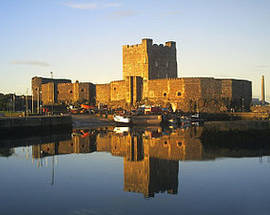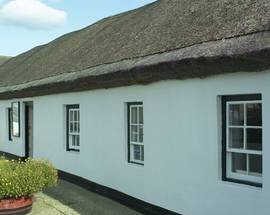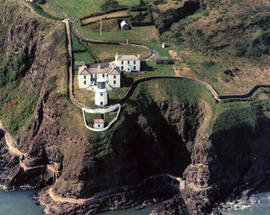Belfast - Larne Harbour by rail
York Road was a large station, one of three mainline terminals in the city (Great Victoria Street served the North, South and West and Queen’s Quay the East and South), but was closed when all the lines to and from Belfast were brought together in 1976. A small station was subsequently opened at Great Victoria Street.
The station and railway works were badly damaged in an air raid in 1941 and the Midland Hotel, alongside the station, was destroyed. The hotel was re-built in the 1960s but eventually closed.
The Belfast-Larne Harbour line takes just over one hour to complete, but it is one of the most spectacular routes in Northern Ireland, running through the city centre – on an elevated track – past Cave Hill and alongside the County Antrim side of Belfast Lough (the opposite side is County Down) before turning briefly inland to serve such villages and hamlets as Whiteabbey, Jordanstown, Greenisland, Trooperslane, Clipperstown, Carrickfergus, Whitehead, Larne Town and the bustling ferry terminals at Larne Harbour.
Much of its journey is along the shores of Belfast Lough and Larne Lough, with mountains and rolling countryside to the left. The trains use a double track until they reach Whitehead and from there to Larne Harbour it becomes a single track through Ballycarry, Magheramourne, Glynn and Larne Town.
BELFAST CENTRAL-YORKGATE
Leaving Central Station the train passes the redeveloped Laganside – through what was once Maysfield railway cattle stockyards – with its gleaming new office blocks, luxury apartments, hotels and, to the left, the magnificent Belfast Waterfront Hall.
Coming up to the right the listed yellow cranes at Harland & Wolff – once the largest shipyard in the world – dominate the city skyline. And below them is the Odyssey Arena, a large concert hall and home to professional ice hockey club the Belfast Giants.
Look carefully to the right and you can see the silvery-hued Titanic Belfast and SS Nomadic, the latter a surviving link with the ill-fated Belfast-built Titanic. The Nomadic was found in an almost derelict state in France – it once ferried First and Second Class passengers to Titanic – and brought back to Belfast to be restored as a centrepiece of the growing Titanic Quarter.
The route crosses the River Lagan and branches to the left from the Belfast-Bangor line. It re-crosses the Lagan and travels above the city to the Yorkgate halt, a small red-brick station built in 1975 to replace York Road. On this leg, look left to see St Anne’s Cathedral, its recently added needle spire making it one of the city’s tallest structures. And on the right the River Lagan opens into Belfast Lough.
YORKGATE-WHITEABBEY
Shortly after leaving Yorkgate, look for Midland House, a grey building to the left. This was once the Midland Hotel. What was York Road station is now the large Northern Ireland Railways Central Maintenance Depot yards. On the left, shortly afterwards, is Seaview, home of Irish Premier League club Crusaders.
Rising on the left, Cave Hill is famous for Napoleon’s Nose (the outline of the Hill resembles a man’s profile), Belfast Castle (seen amid the trees) and Belfast Zoo. In the cliff-face can be seen two caves. Cave Hill ascends 360m to the cliff face of McArt’s Fort, named after the 16th Century chieftain Art O’Neill. The Castle is built in the Scottish Baronial style.
WHITEABBEY-JORDANSTOWN
Whiteabbey is a small station serving the nearby commuter village, though it was once a fully-manned and much busier stop on the line. From Whiteabbey the line climbs towards the now disused Bleach Green Junction, where the Belfast-Londonderry line diverges. Bleach Green got its name from the once-thriving linen industry when raw linen was spread out in the fields to bleach in the sun.
The line goes under one of the most historic railway viaducts in the British Isles on the left (though the structure is better seen on the return journey). The viaducts – two of them, built as part of the Greenisland Loop Line in 1934 – comprise the largest reinforced concrete bridge in the British Isles. They are 630ft long, have a span of 89ft and used 17,000 cubic yards of concrete and 700 tons of steel.
Jordanstown is a small station serving the Ulster University, most of whose staff and students are set to relocate to Belfast city centre by 2018. The University also has centres in Belfast and Coleraine – on the Belfast-Londonderry line. Northern Ireland has two Universities, the other is Queen’s University in Belfast. Though this section of the line is inland, glimpses of Belfast Lough can be seen on the right.
JORDANSTOWN-CARRICKFERGUS
Leaving Jordanstown look to the hill on the left. This is Knockagh and on top can be seen the Knockagh Monument, a 110ft high local basalt obelisk with bronze panels, a replica of the Wellington Monument in Dublin’s Phoenix Park, listing the names of those from County Antrim who died in the two World Wars.
It stands at 935ft above sea level, the largest war memorial in Northern Ireland, and was started in 1922 and completed in 1936. The inscription on the monument is taken from the hymn O Valiant Hearts by John S. Arkwright.
Long before Belfast emerged at the chief city in Northern Ireland Carrickfergus was a thriving centre: ships were built in the historic town. Though it can be seen better on the return leg of the journey, the most famous landmark is the Anglo-Norman castle, one of the best preserved in the British Isles. It towers over a small harbour alongside which a modern, popular marina has been built. It was in the harbour that William, Prince of Orange, landed with his troops on his way to the Battle of the Boyne in 1690.
Though many of the stations on this route, and the others around Northern Ireland, are now small, unmanned halts, Carrickfergus is a wonderful example of a preserved station. Most of its original features remain – elaborately carved woodwork, well-maintained buildings – and the platforms are covered with colourful flower displays. The station has, rightly, won several ‘well kept’ awards.
There are actually three working stations/halts in Carrickfergus. Greenisland, serving a nearby small village, makes way for Trooperslane (really just a level crossing), Clipperstown and Carrickfergus. There were five stations within the town boundaries but Barn and Mount have long been closed. So close are these halts that Clipperstown can be seen from the Carrickfergus platforms.
CARRICKFERGUS-DOWNSHIRE
As the train passes through Carrickfergus the line begins to hug the shore of Belfast Lough at low level to Downshire. Across the Lough is County Down, Bangor and the Copeland Islands (once inhabited but now an important bird sanctuary. The lighthouse is still in operation).
Just beyond Downshire, on the left, look for a whitewashed, thatched cottage. This is the ancestral home of Andrew Jackson, 7th President of the United States. His parents lived there until emigrating to America in 1765. The site also houses the museum of the famous US Army Rangers Regiment, which was formed in Carrickfergus in June, 1942.
DOWNSHIRE-WHITEHEAD
Out of Downshire, still running along the Lough shore, the train passes the now-closed halts at Eden and Kilroot. The latter is famous for its connection with Jonathan Swift, author of Gulliver’s Travels, who served in the local church from 1695 to 1696.
There was a church established in the area in 412AD, pre-dating even Saint Patrick. The area is also famous for its salt mines. In Belfast Lough, in 1778, John Paul Jones, father of the United States navy, fought a battle with the English 20-gun sloop-of-war HMS Drake. Several World War One German U-Boats are said to lie in the waters off the mouth of the Lough. Shortly before arriving at Whitehead look to the right and see the White Harbour. This was once a thriving harbour for boats carrying ore and stones from local quarries to England and Scotland. It also provided a ferry service from Belfast.
WHITEHEAD-BALLYCARRY
Whitehead is a charming little Victorian-Edwardian seaside town 20 miles from Belfast. It regularly wins ‘In Bloom’ awards for its beauty. In many ways it owes its development to the railway since its location on a small bay attracted people from Belfast on holiday.
It acts as the gateway to the peninsula of Islandmagee and, after a post-WW2 downturn in its fortunes as a resort, it is now a fashionable commuter town within 45 minutes from central Belfast.
Whitehead, a town with no streets (all are avenues, terraces, parks, crescents), lies between limestone and black volcanic cliffs, the latter giving the lighthouse beyond the town on Muldersleigh Hill its name: Blackhead. You can overnight at one of two Blackhead Lightkeeper's Houses via the Irish Landmark Trust.
Like Carrickfergus, the station is a perfect example of railway architecture, well maintained, spotlessly clean and actually manned. It had just one platform and an old carriage as a waiting room in 1864 but the new station was opened in 1877. It once boasted a refreshment room, which caused some trouble. In 1883 the Women’s Temperance League demanded the sale of tea as well as stronger drinks and that the station close after the last train.
Today the town is noted for its colourful seafront houses and for it being the headquarters of the excellent Railway Preservation Society of Ireland. The Society, which does great voluntary work in preserving Ireland’s railway heritage (and in running popular steam-train excursions on the main lines), has its own station, the old Whitehead Excursion Station just beyond the station. The Society carries out vital maintenance and overhaul work and runs its own shop. As the mainline train leaves Whitehead to the right you can see rows of old engines and coaches awaiting restoration.
The train runs alongside the local golf course with Islandmagee on the right. Soon after leaving Whitehead the head of Larne Lough appears, opening out towards the halt at Ballycarry.
Ballycarry is joined to Islandmagee by a causeway across the Lough. Here, until further down the line at Magheramourne, the Lough is badly silted up, though that has turned it into an important sanctuary for waterfowl: plenty of seagulls, ducks and swans.
Ballycarry is supposed to serve the village of the same name, but it isn’t all that near. Look to the left after leaving Whitehead and you can see the village high in the hills. It is a beautiful and historic little village. It is home to the oldest Presbyterian congregation in Ireland, the church was founded in 1613 and the present church was built in 1830. One of its famous sons was James Orr, known as the Bard of Ballycarry, who was one of the great Ulster Weaver Poets and a contemporary of Robert Burns.
Ballycarry station is a shadow of its former glory when it was used as a stepping-off place for Islandmagee. When Whitehead was at its peak as a resort, people would get the connecting train from Belfast to catch the buses waiting in the square for all parts of Islandmagee. If they missed this connection they would travel on to Ballycarry and walk across the causeway to the island.
In Northern Ireland several former station buildings and station-master’s houses around the various lines have been bought and turned into private homes. The platform on the left at Ballycarry is a perfect example: a beautiful home with a well-kept garden.
Like Whitehead, Ballycarry is a stepping-off point for the recently reopened Gobbins Cliff walk, at one time an attraction that rivalled the Giant's Causeway for its cliff hugging pathway, caves and tubular bridges above the crashing waves. There is a visitor centre tracing the attraction's history and a shop/cafe.
BALLYCARRY-LARNE HARBOUR
Larne Lough now clearly divides Islandmagee from the mainland as the train heads towards Magheramourne. To the left is a large, now disused – and rather ugly – quarry. There are, however, ambitious plans to turn the area into a wildlife and leisure centre. The line towards the pretty little village of Glynn is built on causeways that form trackside ponds, full of birds.
Larne Town station, sitting on the banks of such a pond, serves the thriving town and Larne Harbour is a mere three minutes away. Here the station shares the facilities – shop, tourist information, café – with the ferry terminal. Larne offers the shortest sea crossing between Ireland and Scotland.









Comments